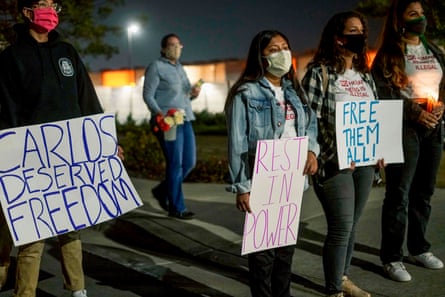Immigrants lacked access to the most basic Covid-19 prevention measures, such as soap for hand-washing, and were retaliated against for raising safety concerns as the pandemic spread through detention facilities last year, according to a new report on the grim conditions at US Immigration and Customs Enforcement (Ice) facilities.
Ice, which oversees immigration detention, created unacceptable health risks and violated constitutional and human rights during the pandemic, said researchers from Physicians for Human Rights (PHR) and Harvard Medical School, who interviewed 50 former detainees for the report.
Ice did not follow its own guidelines for responding to the pandemic, researchers said.
“The guidelines have a lot of great stuff in there about social distancing and hand hygiene and all the things we hope would be in place during a pandemic, particularly in a congregant setting,” said Katherine Peeler, an instructor at Harvard Medical School. “But essentially what we found is that they didn’t adhere to their standards at all.”
PHR and Harvard Medical School researchers interviewed people recently released from 22 different facilities for the report. From 13 July to 3 October in 2020, they spoke with 38 males and 12 females, between 20 and 52 years old. The detainees had traveled from countries including Mexico, Venezuela and Uganda as early as 1980 and as recently as March 2020.

A 33-year-old man at Otay Mesa detention center told the researchers: “I think I got Covid because I had body pain and felt short of breath. But I never said anything to anybody because I was so scared that they were going to punish me.”
The man was one of 21 people interviewed who experienced symptoms of Covid-19. Of the 21, three never reported their symptoms because they were fearful of being stuck in solitary confinement or receiving another punishment. Only three said they were isolated and tested.
The average wait time to see a doctor for this group was four days, while one person waited 25 days. Two people never saw a medical professional after reporting symptoms.
A 41-year-old man with chronic lung disease, who had difficulty breathing, told researchers that staff in the medical office at Stewart detention center “just took my temperature, they didn’t listen to my lungs or ask me questions, they didn’t even let me sit down”.
Since the first weeks of the pandemic, advocates and public health experts have called for the release of all prisoners who don’t pose a risk to the public to limit the illness’s spread. These calls are particularly strong in immigration detention, where people are held on civil, not criminal, charges. There were 16,000 people in Ice custody as of last week and 487 people have Covid-19 currently, according to Ice.
Kathryn Hampton, senior officer of the PHR asylum program, said: “When we’re thinking about access to vaccinations and the new variants, the danger is still not over and that’s why it’s critical people are released.”
Researchers sent the report to the Department of Homeland Security, which oversees Ice, but had not received a response at the time of publication. Ice did not immediately respond to a request for comment.
According to the report, simply acquiring soap is a challenge in the system and 42% of those surveyed said they did not have access to soap at some point in detention. Others reported forgoing other basic necessities to be able to afford soap from the commissary or depended on donations from outside organizations.
A 25-year-old man at Port Isabel detention center told researchers he couldn’t buy soap because he worked in detention to earn money to pay for calls to his family. “People had to choose between buying food from the commissary or bar soap, they couldn’t afford both,” he said.
Social distancing was essentially impossible as 96% of the people surveyed said they slept within 6ft of their nearest neighbor. The rooms they slept in could house as few as two and as many as 100 people and 83% said detainees disinfected the common area themselves.
“We had to take on the initiative to clean the common room, especially after we found out that the sickness was getting worse. We would ask the detention center guards to give us cleaning supplies, but they didn’t,” said a 44-year-old woman held at Adelanto Ice Processing Center.
Solitary confinement is mentioned often in the 51-page report. Some individuals said they were threatened with it after complaining about sanitation to staff, their lawyers or reporters and others said it was misused for medical isolation.
A 33-year-old man at Otay Mesa detention center said a transgender inmate from Mexico was put in solitary confinement for about two weeks after she helped him write to a news organization.
He said: “I was very scared that the same thing was going to happen to me.”
